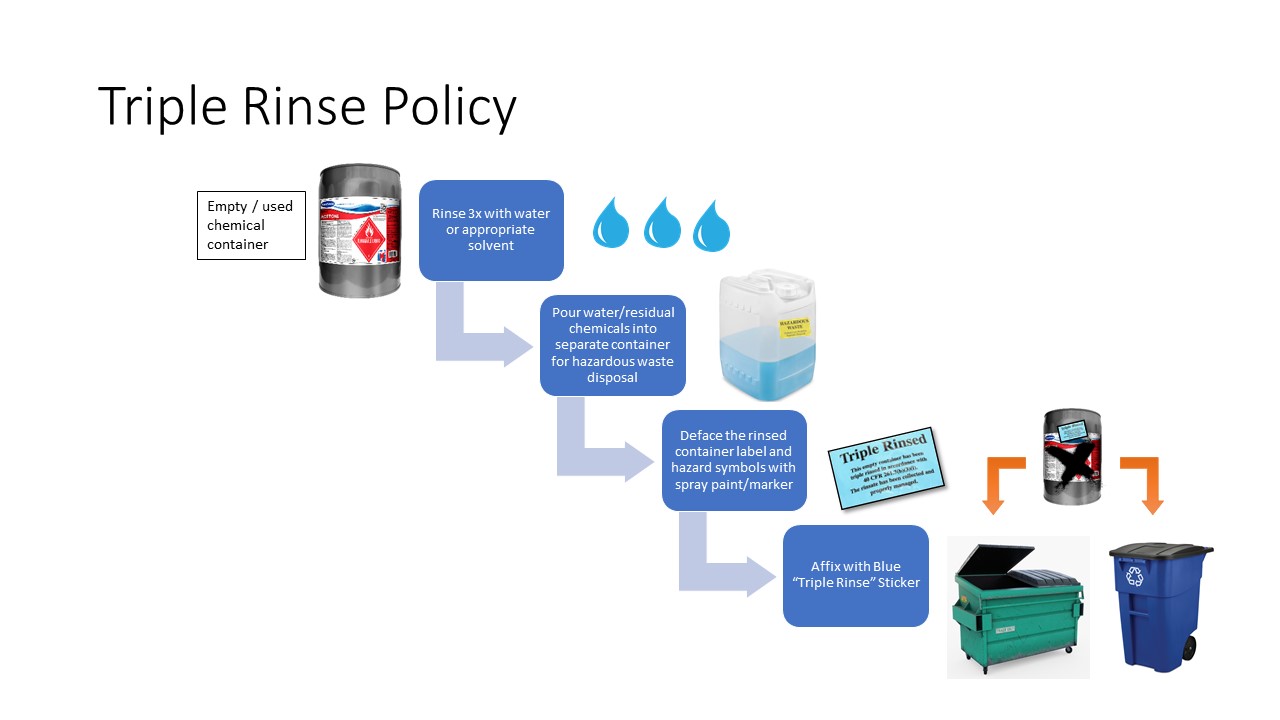Disposing of Empty Chemical Containers
Chemical containers, when emptied of their hazardous contents, can be rinsed out and disposed of through normal municipal trash or recycling. The process and applicable laws are outlined in this page.
The Triple Rinse Process
Once you have removed as much product as possible through traditional means, your empty chemical container can be rinsed and disposed of or reused to store another chemical/waste product.
- Using a solvent capable or removing the contaminant (water, acetone, etc.), rinse out the inside of the container.
- Pour off the solvent/contaminant rinse into a hazardous waste container. You can combine compatible wastes into 1 container, being sure not to combine too many waste streams (waste containers are not a science experiment!).
- Repeat this two more times for a total of 3 rinses. Three is the absolute minimum. If chemical residues remain, you may repeat this process as many times as necessary.
- When the container is empty (criteria below) and ready to be discarded, the label should be defaced and a blue "Triple Rinsed" sticker should be affixed.
Definition of an Empty Container
EPA's RCRA (Resource Conservation and Recovery Act) 40 CFR Part 261, "Identification and Listing of Hazardous Waste" has a subpart pertaining specifically to residues in empty containers. There are several different paragraphs that give different guidance, depending on what was in the container, but treating each container as if it previously held acutely hazardous waste will ensure the most strict treatment of empty containers. Paragraph 3 of 261.7 goes on to state that:
"(3) A container or an inner liner removed from a container that has held an acute hazardous waste listed in §§261.31 or 261.33(e) is empty if:
(i) The container or inner liner has been triple rinsed using a solvent capable of removing the commercial chemical product or manufacturing chemical intermediate;
(ii) The container or inner liner has been cleaned by another method that has been shown in the scientific literature, or by tests conducted by the generator, to achieve equivalent removal"
Empty containers that meet the definition above are not treated as hazardous waste and can be discarded through normal trash or recycling
Reusing Chemical Containers
Occasionally, a lab user may find they are in need of a storage vessel for accumulated wastes or other mixtures. A chemical container that has been triple rinsed can be reused as a waste or storage container, provided the compound that will be put in the container is compatible with the waste that was previously in the container. For example, organic solvent containers should not be used to store acidic wastes even though the container was rinsed.
Use Caution! Not all chemicals are compatible with all containers. Examples: the metal 20L jugs that organic solvents are stored in are not suitable for corrosives; glass containers are not suitable for hydrofluoric acid (HF) wastes, etc.
Gels and Oils
Not all waste containers are able to be triple rinsed clean. For example, gels like ethidium bromide (EtBr) cannot be rinsed out and mechanical action to remove the gels may not be enough to completely clean the container. Lab personnel may find it easier to dispose of the EtBr jars through the Hazardous Waste Program.
Mineral and Silicon oils cannot be easily rinsed out of their container, and using an appropriate solvent may create more unnecessarily hazardous waste. In this case, invert the container for as long as possible (overnight, if you can) over a collection vessel or vacuum pump reservoir to collect as much oil as you can. When no free liquid exists at the bottom of the container you may consult with EHS for the proper route of disposal.
Resources
Part 261- Identification and Listing of Hazardous Waste
6 CRR-NY 371.1(d) (1)(ii)(d)(4) Identification and Listing of Hazardous Wastes (General)
